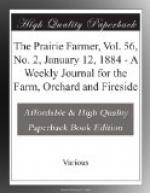T.G.
POSSIBILITIES IN IOWA CHERRY GROWING.
Prof. Budd, of Iowa, sends THE PRAIRIE FARMER the following copy of his address before the Eastern Iowa Horticultural Society, remarking that its appearance in this paper may lead the Bloomington nurserymen to look up this very important line of propagation:
The topic assigned me is, as usual, experimental horticulture. I select the division of the work implied in the heading for the reason that it is, as yet, mainly an unoccupied field of inquiry. If the idea occurs that my treatment of the question is speculative rather than practical permit me to suggest that thought and investigation must always precede the work of adapting fruits to a newly occupied country, especially if that country is as peculiar in climate and soil as the great Northwest.
In the summer of 1882, I was fortunate in having a fine opportunity for studying the varieties and races of cherries in Continental Europe. The fruit was ripening when we were in the valley of the Moselle in France, and as we went slowly northward and eastward it continued in season through Wirtemberg, the valleys and spurs of the Swabian Alps to Munich in Bavaria, through the passes of the Tyrol in Saltzburg to Austria, Bohemia, Siberia, Poland, and Southwestern Russia. Still farther north of St. Petersburg and Moscow we met the cherries from Vladimir on every corner, and our daily excursions to the country permitted the gathering of the perfectly ripened fruit from the trees.
Still again when we passed six hundred miles east of Moscow we had opportunities for picking stray cherries of excellent quality from trees standing near the 56th parallel of north latitude.
To undertake to tell of the varieties of the fruit and the relative hardiness of the trees—as estimated from the behavior of varieties we knew something of—of the many varieties and races we studied on this extended trip would make too long a story. On the plains of Silesia, north of the Carpathian mountains we first began to be intensely interested in the cherry question. Here the cherry is the almost universal tree for planting along division lines and the public highways. As far as the eye could reach over the plains when passing over the railways, the cherry tree indicated the location of the highways and the division of estates. As we passed the highways running at right angles with the track we could get a glimpse down the avenues to a point on the plain where the lines seem to meet, and we were told that unbroken lines along the highways were often found thirty to fifty miles in length.




